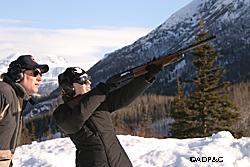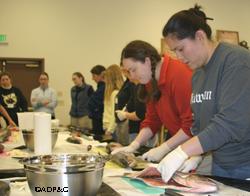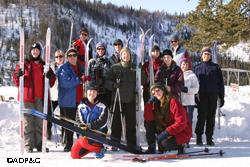Alaska Fish & Wildlife News
February 2007
With the Right Tools and a Little Encouragement
BOW Workshops Open the Door to the Outdoors

I wake at 5:30 a.m. like a kid at Christmas, too excited to sleep. Today for the first time, I will make a dream come true. As a little girl I dreamed of standing on the skis of a sled and watching the team of dogs run across a breathtaking landscape.
How is this possible? How could a girl from the Midwest ever learn to manage a dog team? Becoming an Outdoors-Woman means, “Becoming more competent, more confident, and more aware.” That describes me perfectly as I pulled the hook from the snow and let the dogs fly, with my heart racing and a huge smile on my face. It was an experience I’ll never forget.
The Becoming an Outdoors-Woman (BOW) program offers a range of outdoor skills classes in one weekend. The goal is to offer a supportive and non-threatening environment for uninitiated people (primarily women, but men can and do participate) to learn skills so they may enjoy the outdoors. Where else can you learn chain sawing, bear safety, field dressing big game, snow machining, Dutch oven cooking, archery, fly fishing, and snowboarding in one weekend?
A happy BOW workshop participant said, “I registered to learn the skills necessary to start making my dreams come true.”
Another woman added, “I can’t believe what this weekend did for my self esteem.”
Generally, one third of the classes offered relate to hunting, one third focus on fishing, one third teach outdoor skills. A typical workshop offers room for about 100 participants. Usually 20 different classes are offered and participants choose four courses over a three day period. Each course is around three-and-a-half hours and features hands-on learning.
Prior knowledge is not a prerequisite. One participant noted, “Many questions were asked and answered and there wasn’t one person who felt intimidated by their lack of knowledge.”
The BOW weekend seems to fly by. Classes begin on Friday afternoon and run through Sunday afternoon. As women gather in the mess hall for a briefing on the day’s activities, the room is abuzz with excitement and eagerness to gear up and get outside. After the sessions we gather again and share stories from our exciting first class.

Once the day is over, the evening program starts. With a little coaching from Larry Lewis (ADF&G, fish and wildlife technician, Soldotna), the women learn how to call moose. Laughter spreads through the large room as we practice our bull, cow, and calf calls. There will be a contest the following evening to see who can make the best moose call. We are instructed to practice, practice, practice.
Following the moose calling lecture is a fashion show. This is not your ordinary fashion show. The clothing displayed by BOW participant models consists of gear we may find helpful for some of the outdoor activities we’ve just learned. For example, shooting vests for those who just felt the kick of a shotgun, Gortex gloves for our flyfishers, perhaps a new pair of boots for snowshoeing, or a pair of long johns for cross-country skiing.
My passion for teaching led me from being a student the first winter to being an instructor the next. I taught a canning and smoking class with Katie Sechrist (ADF&G, information officer, Anchorage) and we had a helping hand from Dave Rutz (ADF&G, fisheries biologist, Palmer.) We start at the very beginning: each participant is given a whole salmon and we instruct them how to fillet it. It was the first time some students had ever touched a fish. The hands-on aspect of each class builds confidence and demonstrates how easy and fun it is to learn new skills.
A first-timer shared her goal, “I can’t wait to can and smoke my fish this summer now that I know how to do it!”
BOW co-coordinator and instructor Kirk Lingofelt (ADF&G, education associate, Anchorage) said he was hooked on the program after he taught his first class.

“It is an excellent opportunity for people to get training that most likely they can’t get anywhere else,” he said. “It’s amazing how all of the workshops fill up. There is a large audience out there desiring this type of education. With every BOW it is never a question of is it going to sell, but, how fast will it sell out.”
BOW benefits resource management agencies as well as participants. Students gain an understanding of environmental stewardship and a sense of ownership of the resources they use. If they learn more skills and are more comfortable outdoors, their awareness and concerns about conservation will increase and they will be more likely to take part in decision-making. In addition, about 80 percent of single-parent families are headed by women. If single mothers are more comfortable outdoors, they are more likely to teach their children appreciation and respect for wildlife and habitat. In the future, those children will help make the decisions about wildlife and habitat.
The program is designed to be coordinated by a natural resource management agency. The founders of BOW believed that resource agencies are better able to provide equal emphasis on all three focus areas (hunting, fishing, other outdoor skills) than private business or interest groups. In a few states, interest groups are sponsors of the program, but oversight is provided by management agencies and national BOW staff.
You may contact Tracy Smith, Education Associate I at ADF&G in Anchorage at 907-267-2896 regarding winter BOW workshops or Nancy Sisinyak, Information Officer II at ADF&G in Fairbanks at 907-459-7207 regarding summer BOW events.
Samantha Oslund is a Fish and Wildlife Technician III with the Division of Sport Fish in Anchorage.
Subscribe to be notified about new issues
Receive a monthly notice about new issues and articles.
